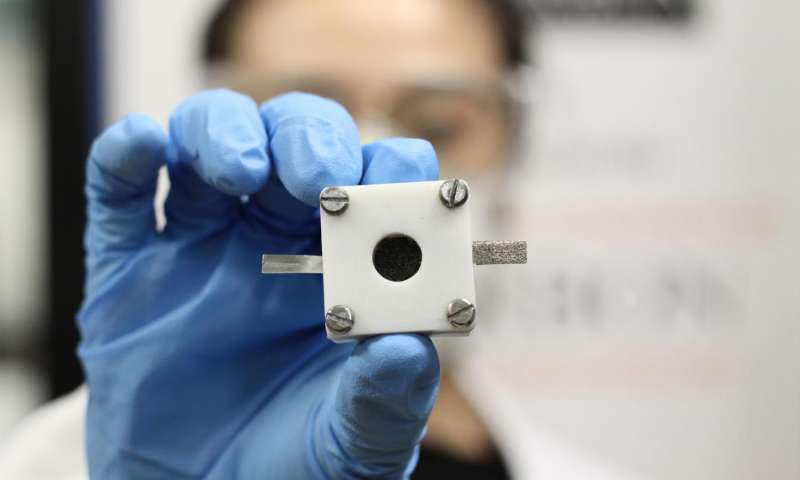博文
锌-空气电池:三管齐下可彻底改变反复充电特性
 精选
精选
|||
锌-空气电池:三管齐下可彻底改变反复充电特性
诸平
据悉尼大学(University of Sydney)2017年8月15日提供的消息,悉尼大学的研究员已经开发出可以反复充电放电的锌-空气电池(详见图1)。

Fig 1 University of Sydney researcher holds up a rechargeable zinc-air battery. Credit: The University of Sydney
悉尼大学的研究人员发现了一个解决阻止锌-空气电池在电子设备的电源选择方面,取代传统锂离子电池的最大障碍的方案。
锌-空气电池是由金属锌和空气中的氧气构成的电池。由于全球金属锌资源丰富,因此生产此类电池比锂离子电池更便宜,成本更低。它们也可以存储更多的能量(理论上是锂离子电池的5倍以上),而且更安全和更环保。
目前锌-空气电池作为能源用于助听器和一些胶片相机以及铁路信号设备,其广泛使用一直受阻,其最大障碍就是其充电问题,已被证明是困难的。这是由于在电池放电和充电过程中,缺乏成功进行还原并生成氧气的电催化剂(electrocatalysts)。
2017年8月14日在《先进材料》( Advanced Materials)杂志网站上发表了悉尼大学(University of Sydney)和南洋理工大学(Nanyang Technological University)化学工程研究人员合作撰写的一篇论文,阐述了一种新的三步法来克服这以难题。详见Li Wei, H. Enis Karahan, Shengli Zhai, Hongwei Liu, Xuncai Chen, Zheng Zhou, Yaojie Lei, Zongwen Liu, Yuan Chen. Amorphous Bimetallic Oxide-Graphene Hybrids as Bifunctional Oxygen Electrocatalysts for Rechargeable Zn-Air Batteries(点击可以下载原文). Advanced Materials, First published: 14 August 2017, DOI: 10.1002/adma.201701410.
根据来自悉尼大学工程和信息技术学院(University of Sydney's Faculty of Engineering and Information Technologies)的领导作者陈远(Yuan Chen音译)教授介绍,为了从头构建可充电锌-空气电池,他们的新方法可以用来创建双功能氧电催化剂。陈教授说:“迄今为止,充电锌-空气电池已经将昂贵的贵金属如铂和铱氧化物等用作为催化剂。相比之下,我们的新方法可以产生一系列新的高性能和低成本的催化剂。”
通过同时控制下面步骤来生产这些新的催化剂:其一是组成;其二是大小;其三就是地球上丰富元素如铁、钴、镍金属氧化物的结晶度。然后,它们就可以用来构建可充电的锌-空气电池。
论文的第一作者、悉尼大学化学与生物分子工程学院的魏丽博士(Dr Li Wei音译)说,用新催化剂开发的锌-空气电池的试验已经证明具有优良的可充电性(excellent rechargeability),包括放电/充电循环周期超过60次,时间为120小时,但是其电池功率下降不足10%。陈教授补充说:“我们正在解决对我们社会而言,实现更可持续的金属-空气电池的基础性技术挑战。”
更多信息请注意浏览原文或者修改其他报道:
Breakthrough enables safer alternative to lithium-ion batteries
Zinc-air batteries: Three-stage method could revolutionise rechargeability
Abstract
Metal oxides of earth-abundant elements are promising electrocatalysts to overcome the sluggish oxygen evolution and oxygen reduction reaction (OER/ORR) in many electrochemical energy-conversion devices. However, it is difficult to control their catalytic activity precisely. Here, a general three-stage synthesis strategy is described to produce a family of hybrid materials comprising amorphous bimetallic oxide nanoparticles anchored on N-doped reduced graphene oxide with simultaneous control of nanoparticle elemental composition, size, and crystallinity. Amorphous Fe0.5Co0.5Ox is obtained from Prussian blue analog nanocrystals, showing excellent OER activity with a Tafel slope of 30.1 mV dec−1 and an overpotential of 257 mV for 10 mA cm−2 and superior ORR activity with a large limiting current density of −5.25 mA cm−2 at 0.6 V. A fabricated Zn–air battery delivers a specific capacity of 756 mA h gZn−1 (corresponding to an energy density of 904 W h kgZn−1), a peak power density of 86 mW cm−2 and can be cycled over 120 h at 10 mA cm−2. Other two amorphous bimetallic, Ni0.4Fe0.6Ox and Ni0.33Co0.67Ox, are also produced to demonstrate the general applicability of this method for synthesizing binary metal oxides with controllable structures as electrocatalysts for energy conversion.
https://blog.sciencenet.cn/blog-212210-1071391.html
上一篇:YD277:治疗乳腺癌潜在新药(附原文)
下一篇:h-BN泡沫吸收CO2,循环2000次,吸附量340%(附原文)